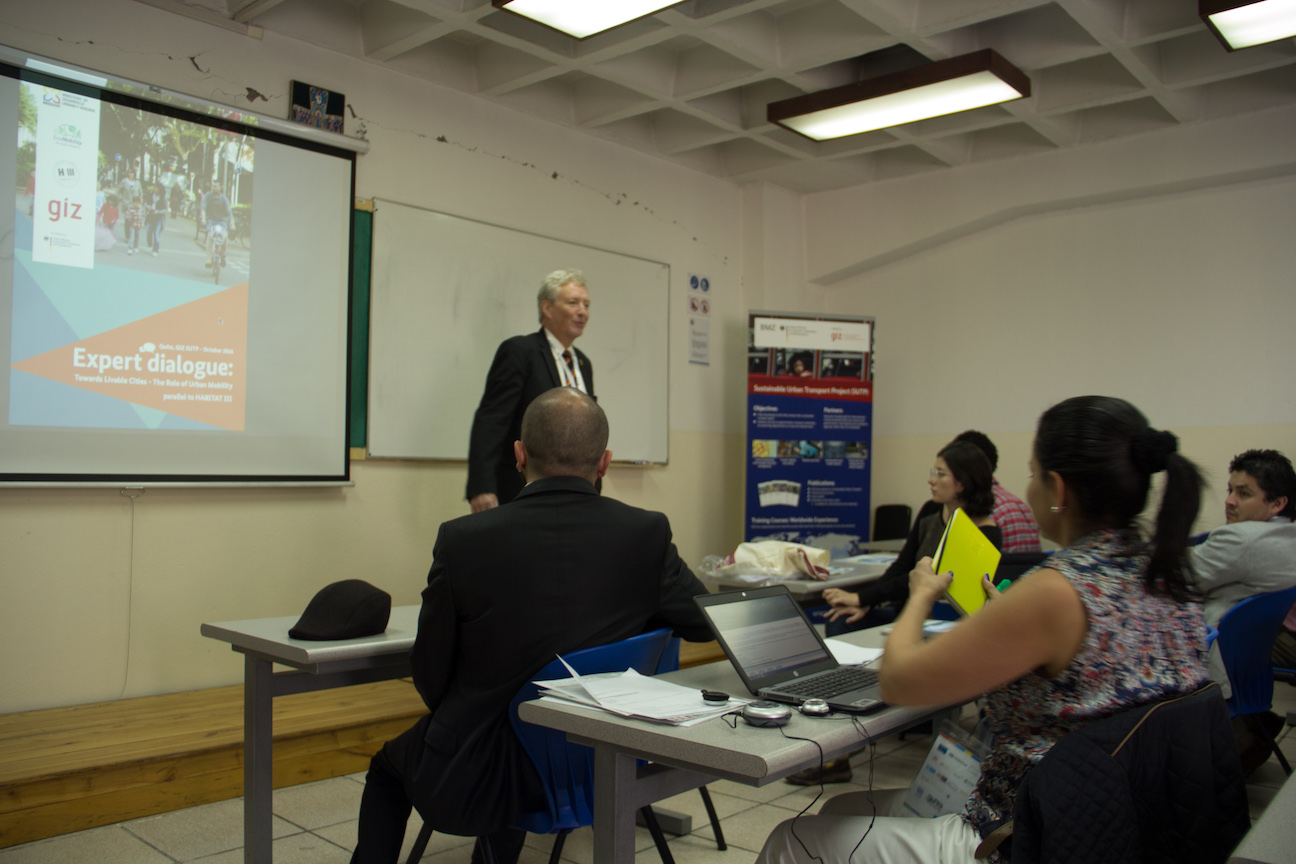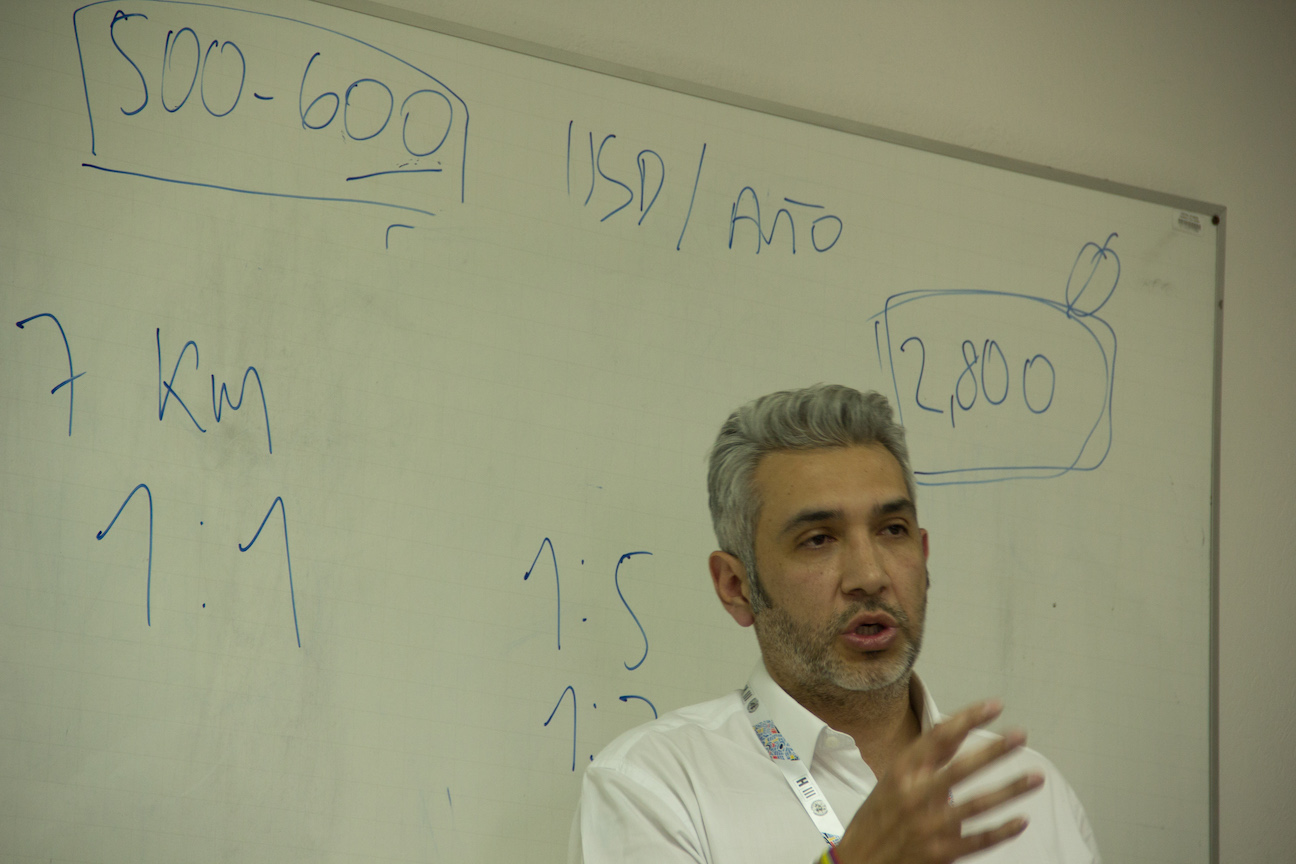Training Course: Towards Livable Cities- The Role of Urban Mobility
Organized by GIZ SUTP, ICLEI Ecomobility, Ministerio de Desarrollo Urbano y Vivienda (MIDUVI) and with support from WRI Ross Center for Cities.
Quito, Ecuador, October 20, 2016
Lessons towards livable cities through urban mobility
It has proven time and again in many cities that building automobile friendly infrastructure will not solve the traffic challenges in cities. This approach not only worsens air quality but also affects other areas such as quality of life, accessibility and worsens congestion. By increasing the mobility options and access to these options, ecomobility can become more attractive in cities. Cities that have provided favorable, safe and accessible walking and cycling infrastructure along with integration to affordable and effective public transport systems have successfully increased the share in these modes.
Introduction and welcome
Inauguration by Franz Marré, Federal Ministry for Economic Cooperation and Development, Germany and Ma de los Ángeles Duarte, Ministra, Miduvi
To address livability in cities, urban mobility plays a crucial role due to its cross sectoral nature. Mobility affects quality of life, public health, air quality and save lives. To explore this and as part of the EcoMobility Days 2016 Quito, a training course titled “Towards Livable Cities- The Role of Urban Mobility” was organized by GIZ SUTP, ICLEI Ecomobility, Ministerio de Desarrollo Urbano y Vivienda (MIDUVI) and with support from WRI Ross Center for Cities. Over 30 city officials, academics, and participants of the HABITAT III conference took part in this training.
The one-day training course was organized to generate knowledge on livability and its impact on urban mobility, linked to the topics discussed at the Habitat III conference in Quito. This full day expert dialogue described the challenges of creating livable cities and the role that urban mobility can have to increase livability while reducing carbon emissions and improving travel conditions for citizens. To provide greater insights on such issues, the course described key elements of livability and focused on sustainable mobility and its components. It also provided an overview of the available tools and policies to implement such measures and presented various resources that were useful to this topic in cities of the developing world.
Experts conducting the training included, CarlosFelipe Pardo, Executive Director of Despacio; Santhosh Kodukula, Program Manager of EcoMobility; Dr. Dario Hidalgo from EMBARQ; and Nicolás Estupiñán, international transport policy advisor from CAF- Development Bank of Latin America. Experts provided important input on different aspects of the course which ranged from diverse aspects of the topic of urban mobility and livable cities including policies, land-use planning, accessibility, public transport reform, non-motorized transport, Travel demand Management, integration and sustainable mobility in the context of Latin America.
Participants
Over 30 city officials, academics, and participants of the HABITAT III conference took part in this training
- The first part of the training course was on the role of urban transport and land- use planning towards creating equitable and liveable cities. Numbers revealed that around 80% of the population is urban in Latin America, and the figures continue growing. This is also the case in Ecuador with 70% of urban population. Along with high urban population growth, is growing motorization rates, in particular those from motorcycles. Challenges in Latin America where presented including lack of coordination among institutions influencing urban mobility and land use plans. The uncoordinated approach leads to negative impacts such as traffic related fatalities, air quality diseases and high CO2 emissions. Priorities need to be re-established in favour of people and active mobility, shifting conventional urban planning towards infrastructure for ecomobility.
- The following part of the training was dedicated to public transport reform, non-motorized transport, as well as integration and implementation of Travel demand Management. In regards to a transport reform, cities need to continue innovating and adapting and Latin America already offers excellent examples of national policies that helped cities invest in ecomobility such as Brasil, Colombia and Mexico. There are also good examples of tools such as “’restrictive car parking policies’. In many cities, such as Amsterdam for instance, the policy to make car parking expensive in (and around) city-centreshas proven to be an extremely effective measure to reduce car-use (to the city-centre) and promote cycling. In the 90’s this was THE reason of the increase of cycling to the city-centrein Amsterdam. More important than cycling infrastructure.”
- The remainder of the training focused on diverse conceptual aspects of ecomobility and also involved the participants in an interactive exercise of allocating fictional funds available for various mobility projects. The exercise revealed that ecomobility investments are not only inexpensive but also effective in terms of size, when compared to capital intensive public transport projects and car friendly infrastructure. Around 10-25% of the urban areas are however occupied by roads and around 5% of the Gross domestic product (GDP) is spent in transport subsidies.
To download the presentations of this course please visit: www.ecomobility.org/ecomobility-days-quito/. EcoMobility conducts regular training courses in cooperation with the German Cooperation (GIZ) and its SUTP project.






